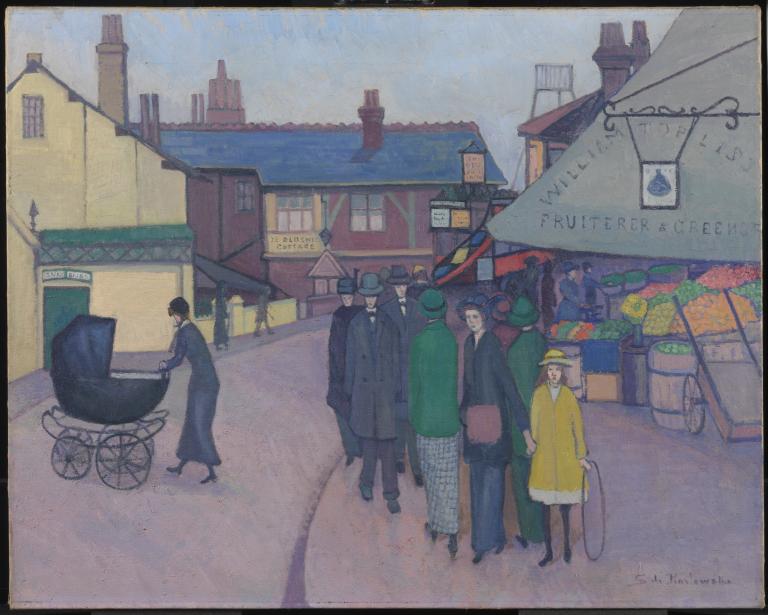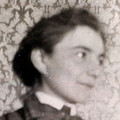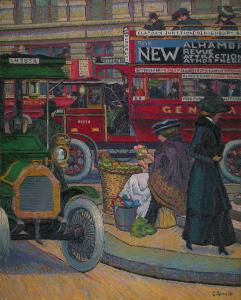Stanislawa De Karlowska Swiss Cottage exhibited 1914
Stanislawa De Karlowska,
Swiss Cottage
exhibited 1914
The location shown in this painting is the intersection of Finchley Road, Fitzjohn’s Avenue and Adelaide Road in Swiss Cottage, London, where Karlowska and her husband Robert Bevan lived. Karlowska’s figures crowding the pavement seem deliberately elongated, heightening the liveliness of the local scene. A girl with a hoop in bright yellow overcoat stares back at the observer with a directness that is reminiscent of a number of contemporary photographs of street life.
Stanislawa de Karlowska 1876–1952
Swiss Cottage
Exhibited 1914
Oil paint on canvas
610 x 760 mm
Inscribed ‘S. de Karlowska’ bottom right, ‘DAIRY DAIRY’ on sign above door on left, ‘YE OLD SWISS | COTTAGE’ on building at centre, ‘THE | OLD | SWISS | COTTAGE’ on pub sign and ‘WILLIAM TOPLISS | FRUITERER GREENGR’ on awning
Presented by the artist’s family 1954
N06239
Exhibited 1914
Oil paint on canvas
610 x 760 mm
Inscribed ‘S. de Karlowska’ bottom right, ‘DAIRY DAIRY’ on sign above door on left, ‘YE OLD SWISS | COTTAGE’ on building at centre, ‘THE | OLD | SWISS | COTTAGE’ on pub sign and ‘WILLIAM TOPLISS | FRUITERER GREENGR’ on awning
Presented by the artist’s family 1954
N06239
Ownership history
By descent to Robert Alexander Bevan (1901–1974), the artist’s son, and presented by him and the artist’s family to Tate Gallery 1954.
Exhibition history
1914
Seventh Exhibition of the Allied Artists’ Association, Holland Park Hall, London, June–July 1914 (20).
1915
Second Exhibition of Members of the London Group, Goupil Gallery, London, March 1915 (3).
1954
Memorial Exhibition of Paintings by S. de Karlowska, Adams Gallery, London, October 1954 (9).
References
1955
Tate Gallery Report 1954–55, London 1955, p.17.
1964
Mary Chamot, Dennis Farr and Martin Butlin, Tate Gallery Catalogues: The Modern British Paintings, Drawings and Sculpture, vol.1, London 1964, p.349.
2004
Alicia Foster, Tate Women Artists, London 2004, p.89, reproduced.
Technique and condition
Swiss Cottage is painted in artists’ oil paints on what appears to be a commercially primed canvas. The fine, plain weave cloth, probably linen, seems to have an animal glue sizing and white oil priming overall. The thin, even layer of priming retains the texture of the canvas weave and has good adhesion to it.
The primed canvas was stretched onto the four-member stretcher and may retain its original attachment. At some time the tacking edges began to fail and all the edges have been covered in situ with strips of fabric and tough glue. This strip-lining is in stable condition and covers the original rusted steel tacks and split and torn tacking edges that may have been damaged as a result of wear from the sharp edges of the stretcher bars.
There is no initial drawing visible; outline and other linear elements are continuous with the painting at all levels. Outlines are not used consistently across the painting but are dominant in some areas such as the departing bus, which has luminous colours within dark contours like stained glass. The general shape of each object is filled in with local colours that are gently modulated to describe form and occasionally add details. A few areas of the first colouring remain unmodified by subsequent work. One such area is the upper sky where the bold broken brushwork reveals the priming. Karlowska has re-worked most areas to achieve the desired colour balance. Some changes are marked, such as the repainting of the fruiterer’s awning at the right from pink to grey green. In other areas the re-workings are developments and modifications rather than complete revisions of earlier work. Select elements, such as the figures on the far pavement, appear to have been added as an afterthought over earlier work. The re-working of the yellow walls of the left-hand building and of the sky around the chimney pots appear slightly darker in tone than intended compared to adjacent areas, suggesting that these changes were also made after the initial painting had thoroughly dried. The toning down of the strong local and contrasting colours in the middle distance gives a greater sense of space and draws focus to the strong local colour such as the bus and fruit and the foreground figures. The intermixing of vibrant colours is used to add interest to the surface of the road while the strong purple shade of the far pavement is reduced by scumbling over with grey. Although there is no general varnish layer, variations in gloss suggest that the surface has been locally saturated by oiling out or applying varnish during painting.
Roy Perry
June 2004
How to cite
Roy Perry, 'Technique and Condition', June 2004, in Robert Upstone, ‘Swiss Cottage Exhibited 1914 by Stanislawa de Karlowska’, catalogue entry, May 2009, in Helena Bonett, Ysanne Holt, Jennifer Mundy (eds.), The Camden Town Group in Context, Tate Research Publication, May 2012, https://wwwEntry
The location of this scene was close to where Karlowska and Robert Bevan lived at 14 Adamson Road, Swiss Cottage. It shows the view south down Finchley Road from the point where it meets Fitzjohn’s Avenue and Adelaide Road, now considerably redeveloped. Ye Old Swiss Cottage pub has since been demolished and rebuilt, but still occupies the same site and has the same name. The yellow building to the left of the pub in the picture was the Swiss Cottage Dairy. Directories of the period list William Topliss (his name appears on a shop awning) as a fruiterer at 131 Finchley Road. The curiously shaped structure rising behind the rooftops on the right, above the bus, remains unidentified, although it has been suggested that it could be connected with the fire station which occupied the spot at this time; it could perhaps be a water tower or a structure for drying hoses.1
Bevan’s painting around this time was much taken up with local street scenes and there is therefore a clear connection between the couple’s choice of subject matter. However, Bevan’s pictures, such as Belsize Park 1917 (Museum of London),2 are often characterised by the lack of human figures, while in Swiss Cottage Karlowska has populated her canvas with bustling shoppers at a busy intersection. Karlowska appears to have deliberately attenuated their bodies, so they appear taller and thinner than would be normal, lending the picture the exaggerated quality of caricature. The manner in which several figures stare back at the viewer – notably the girl with the hoop – recalls photographs of the period in which subjects return the interest of the photographer. Although the Camden Town Group took its name from an urban area, it is surprising how few of their paintings actually depict street scenes, and when they do the human presence is rarely the focus. Ginner’s Piccadilly Circus 1912 (Tate T03096) is a notable exception, although the traffic itself is perhaps most prominent in that work. More than others in the circle, Karlowska and Bevan seem to have been the most interested in the potential of the life of the streets, usually in their immediate neighbourhood, to provide the subject matter of their work.
Robert Upstone
May 2009
Notes
Related biographies
Related essays
- Sex and the City: The Metropolitan New Woman Meaghan Clarke
- The Urban Observer Deborah Longworth
Related catalogue entries
How to cite
Robert Upstone, ‘Swiss Cottage Exhibited 1914 by Stanislawa de Karlowska’, catalogue entry, May 2009, in Helena Bonett, Ysanne Holt, Jennifer Mundy (eds.), The Camden Town Group in Context, Tate Research Publication, May 2012, https://www



